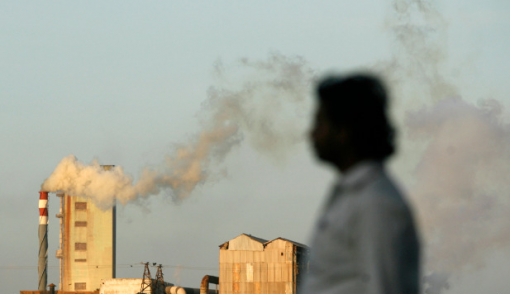
For the first time ever, the year 2014 saw India’s carbon dioxide emissions growth accounting for the largest share of global emissions growth, according to a new global report. India’s CO2 emissions from energy use had increased by 8.1% during the year, making it the world’s fastest-growing major polluter.
It was the single-most significant trend revealed in the latest edition of British Petroleum’s comprehensive Statistical Review of World Energy, but the Indian media got the story upside down. Most coverage celebrated India’s sky-high energy-consumption figures, while glossing over its record-breaking emissions growth, a historical milestone with serious implications.
India bucking a global trend
India’s contribution amounted to 28%, or almost a third of global emissions growth in 2014. That number alone does not convey the magnitude of the larger shift it reflects. Consider these supplementary facts:
Those countries whose CO2 emissions increased in 2014 together added an extra 572 million tonnes (MT) of CO2 to the atmosphere. India’s share was by far the largest at 157 MT of CO2, substantially ahead of China (85 MT) and US (53 MT), the world’s leading polluters for decades.
India’s share of emissions growth (157 MT of CO2) was not only the largest volumetric contribution in its own history, but for the first time made it the world’s biggest contributor to emissions growth.
While every other major polluter saw emissions growth decline considerably, some even managed to cut emissions significantly over 2013 levels. The EU, for instance, cut more emissions (211 MT of CO2) in 2014 than India added.
The additional CO2 India added to the atmosphere in 2014 (157 MT) was greater than that added by the US (155 MT) in 2013. The US’ economy is ten times as big as India’s and consumes nearly four times as much energy.
Trends are reversible, but the pattern that emerges from these numbers clearly point to a pivotal shift. India has bucked a global trend to emerge as the single-most critical player when it comes to carbon emissions, and thereby, climate change.
The triad: energy, growth, emissions
The triad of economic growth, energy consumption and emissions/pollution is joined at the hip. India’s GDP growth, which has driven up energy consumption to a historic high point, is also driving growth in its emissions.
On the other hand, economic growth has slowed globally, leading to a steady decline in global energy consumption in recent years, reaching its nadir in 2014 at just 0.9% (the slowest rate of growth since the late 1990s).
India stays at odds with the world because of a host of supplementary trends: globally-significant emission cuts by the EU, a major Chinese push in renewables, and the “virtual collapse” of highly-polluting industries like coal, steel and cement in China as its infrastructure boom plateaus.
Sharpest divergence in coal
It is in coal consumption that India most diverges from the rest of the world.
When most major countries have minimal or declining coal consumption, India’s coal consumption has grown by 11%, the world’s largest volumetric increase for the year.
Coal is the single biggest source of primary energy in India and China, but from the perspective of climate change and air pollution, it is also the dirtiest. Comparing growth in coal consumption with that of renewable energy gives us a better idea of how India fares against the rest of the world in terms of current energy priorities:
India’s greater reliance on coal is also what accounts for the Indian exception when it comes to the relationship between emissions growth and energy consumption. As the chart below shows, where emissions growth in every major country trailed consumption growth, Indian emissions growth (8.1%) alone outpaced consumption growth (7.1%), pointing to the greater carbon content in its fuel mix.
The Modi government is pursuing one of the most ambitious renewable-energy programmes anywhere in the world, apart from a clutch of energy-conservation schemes. However, as an IndiaSpend report noted earlier, coal remains at the heart of Indian energy policy, with 455 of 1,199 new coal-based thermal power plants proposed worldwide set to come up in India. An IndiaSpend series on energy also explained why this is unlikely to change soon.
A many-sided problem
As the IndiaSpend series showed, it’s only when you apply criteria like population and historical emissions that you get an accurate picture of energy consumption and emissions by countries. But country-wise estimates themselves can be misleading in a globalised economy—where rich nations routinely ‘outsource’ emissions to developing nations.
So, it’s worth repeating: The Indian exception is in the rate of growth in energy consumption and emissions; India’s net consumption and emissions remain low. In per capita terms, India is neither one of the world’s major polluters and nor was its emissions growth rate in 2014 the absolute highest worldwide.
But India’s size, and the consistent rise in its emissions growth puts India in a league of its own. This trend is unlikely to abate since projections show India is set to grow faster than any other major economy, propelled by a massive, coal-fuelled, Chinese-style industrialisation drive.
India taking over from China
The last five years’ data reveals declining Chinese emissions growth (after peaking in 2011 at 7.9%), and accelerating Indian emissions growth. Energy, economic growth and emissions being connected, what we are seeing is the baton being exchanged from one Asian giant to the other, a shift tangentially reflected in recent GDP trends.
The cumulative impact of every ton of carbon, experts say, added to the atmosphere pushes the world that much closer to the brink of irreversible climate change. For largely tropical countries like India, with its huge coastal populations, rainfall-dependent agriculture and glacier-dependent freshwater supply, climate change poses a disproportionately graver threat.
This is what makes these latest numbers so alarming–for the world, but even more so for India.
This article has been republished from Indiaspend.com.